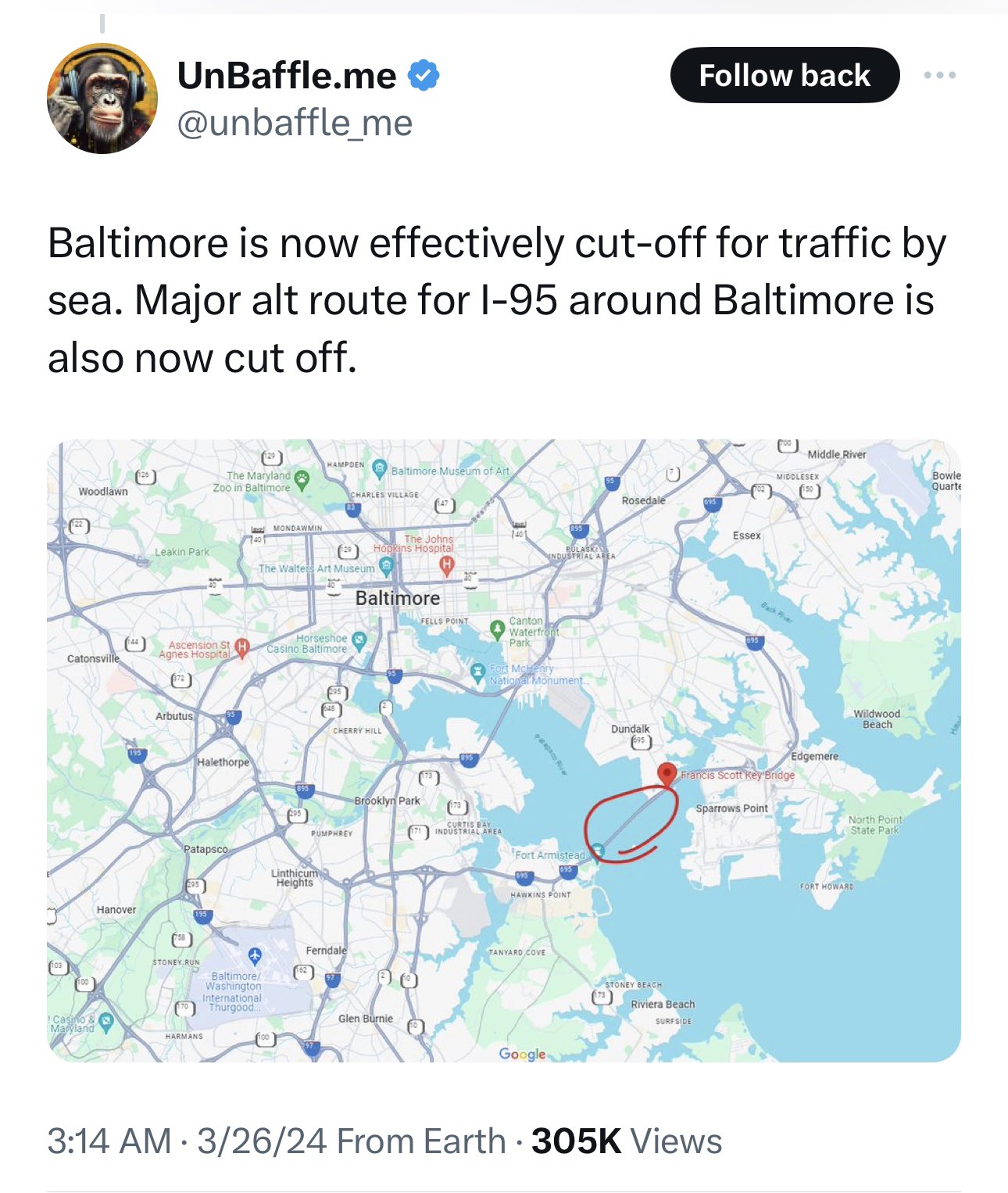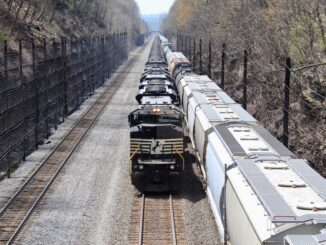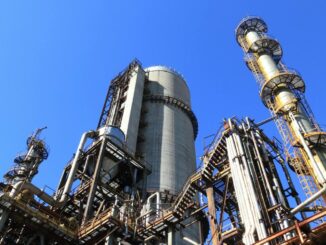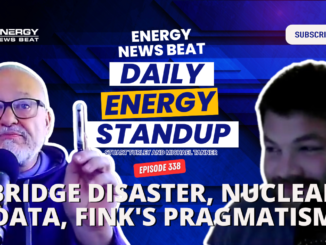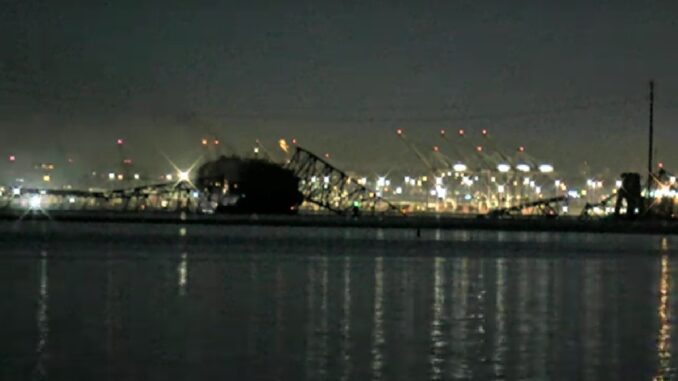
Many are feared dead in Baltimore following a dramatic bridge collapse tonight after the 9,962 teu
Dali containership smashed directly into one of the bridge’s pillars.
The Maryland Transportation Authority and US Coast Guard confirmed an incident on the Francis Scott Key Bridge.
It is being seen as a developing mass casualty incident with multiple vehicles and many individuals said to be in the water.
Reports on the collapse of the longest bridge in Baltimore, and the world’s third-longest continuous truss bridge, came in around 1.30 hrs local time Tuesday. Initial reports suggest there were around 20 people on the 2.57 km long bridge at the time of the incident.
Prayers and condolences to all involved 🙏🏻😔 https://t.co/X0dD3Adk3O
— Riverrat328 (@riverrat328) March 26, 2024
Baltimore mayor Brandon Scott said emergency personnel were at the scene and rescue efforts were underway. There were no immediate reports of casualties. Kevin Cartwright, the director of communications for the Baltimore fire department, said emergency responders were searching for at least seven people believed to be in the water.
The 300 m-long Dali is listed on VesselsValue as owned by Grace Ocean Investment and registered in Singapore. All crewmembers, including the two pilots, have been accounted for and there are no reports of any injuries. There has also been no pollution.
The vessel had left Baltimore at 1 am and was heading for Colombo, Sri Lanka, according to the maritime data platform MarineTraffic. Video footage of the accident suggests the 2015-built boxship lost power intermittently before colliding with the bridge.
🚨🇺🇸 Close up clip of boat hitting structure of Francis Scott Baltimore Bridge.
It’s almost as if the boat was steered to hit the bridge gantry head on? pic.twitter.com/ir2yON7SM6
— Concerned Citizen (@BGatesIsaPyscho) March 26, 2024
The Dali is chartered by Maersk and operated by Synergy Group on the 2M service between Asia and the US East Coast. Maersk said it was closely following the investigations conducted by authorities and Synergy and that none of its crew or personnel were onboard at the time of the incident.
Many of Baltimore’s shipping terminals lie behind the downed bridge with many ships now trapped. The port of Baltimore ranks first nationally in automobiles and light trucks, first in roro cargo, first in gypsum imports, second in imported sugar, and second in exported coal.
Lars Jensen, chief executive at Danish consultancy Vespucci Maritime, described the incident as a major disaster that would create significant problems on the US East Coast for US importers and exporters.
“The bridge collapse will mean that for the time being it will not be possible to get to the container terminals – or a range of the other port terminals – in Baltimore. In 2023 the terminals handled 1.1 million teu. This is some 21,000 teu per week which now has to be routed through other ports in the region. Additionally, this means the cargo already gated into the Baltimore terminals would have to either wait an unknown period for the sealane to reopen, or be gated back out and shifted to a different port,” Jensen wrote on LinkedIn.
From DRW’s Substack and Laura Logan:
Multiple intel sources: Baltimore bridge collapse was an “absolutely brilliant strategic attack” on US critical infrastructure – most likely cyber – & our intel agencies know it. In information warfare terms, they just divided the US along the Mason Dixon line exactly like the Civil War.
Second busiest strategic roadway in the nation for hazardous material now down for 4-5 years – which is how long they say it will take to recover. Bridge was built specifically to move hazardous material – fuel, diesel, propane gas, nitrogen, highly flammable materials, chemicals and oversized cargo that cannot fit in the tunnels – that supply chain now crippled.
Make no mistake: this was an extraordinary attack in terms of planning, timing & execution.
The two critical components on that bridge are the two load-bearing pylons on each end, closest to the shore. They are bigger, thicker and deeper than anything else. These are the anchor points and they knew that hitting either one one of them would be a fatal wound to the integrity of the bridge.
Half a mile of bridge went in the river – likely you will have to build a new one. Also caused so much damage to the structural integrity of the bottom concrete part that you cannot see & won’t know until they take the wreckage apart. Structural destruction likely absolute.
Attack perfectly targeted.
“They have figured out how to bring us down. As long as you stay away from the teeth of the US military, you can pick the US apart. We are arrogant and ignorant – lethal combination. Obama said they would fundamentally change America and they did. We are in a free-fall ride on a roller coaster right now – no brakes – just picking up speed.”
The footage shows the cargo ship never got in the approach lane in the channel. You have to be in the channel before you get into that turn. Location was precise/deliberate: chose a bend in the river where you have to slow down and commit yourself – once you are committed in that area there is not enough room to maneuver.
Should have had a harbor pilot to pilot the boat. You are not supposed to traverse any obstacles without the harbor pilot.
They chose a full moon so they would have maximum tidal shift – rise and fall. Brisk flow in that river on a normal day & have had a lot of rain recently so water was already moving along at a good pace.
Hit it with enough kinetic energy to knock the load-bearing pylon out from under the highway – which fatally weakens the span and then 50 percent of the bridge fell into the water.
All these factors when you look at it – this is how you teach people how to do this type of attack and there are so few people left in the system who know this. We have a Junior varsity team on the field.
Tremendous navigational obstruction. Huge logistical nightmare to clean this up. Number of dead is tragic but not the whole measure of the attack.
That kind-of bridge constantly under repair – always at night because there is so much traffic and they cannot obstruct that during the day. So concern is for repair guys who were on foot (out of their vehicles) working who may now be in the water – 48 degrees at most at this time of year.
When you choke off Baltimore you have cut the main north-south hazardous corridor (I95) in half. Now has to go around the city – or go somewhere else.
To move some of that cargo through the tunnel you may be able to get a permit but those are slow to get and require an escort system that is expensive and has to be done at night.
For every $100 dollars that goes into the city, $12 comes from shipping. Believe this will cripple the city of Baltimore at a time when they do not have the resources to recover.

